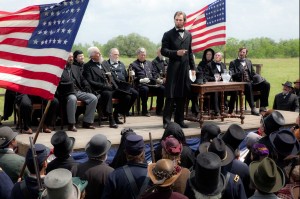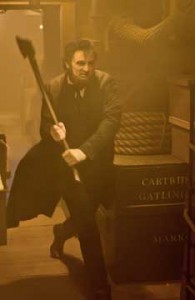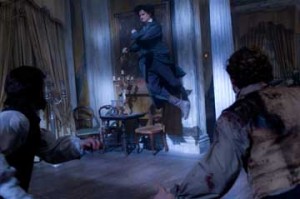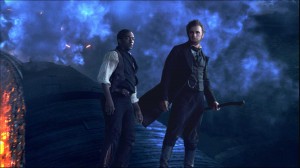
As we approach the Fourth of July, thoughts turn toward American icons like Washington, Jefferson and perhaps even Lincoln. True, the latter is not associated with the Declaration of Independence, but he is one famous American that this year’s summer filmgoers will remember, thanks to his recent incarnation as a vampire hunter.
Surprising as it may be, creative teams behind Abraham Lincoln: Vampire Hunter worked to preserve American history on this project. “I had to brush up on my history,” Method Studios VFX supervisor, Randy Goux said. “Civil war history is abounding on the web.”
Goux explained that the process involved the change in pace from working on vampire decapitations one day, to recreating the Gettysburg Address the next day. The scene in which the historical address took place had around 5,000 digital attendees. It was made complete by historical touches, like a partially-built U.S. Capitol building in the background of Lincoln’s inauguration, and recreations of Abe’s home in Springfield, Ill.

Those aspects of the film might, in part, explain how effects supervisor Michael Owens (Letters from Iwo Jima, Changeling, J. Edgar) wound up on the production, but according to Owens, his work involved more than just visual effects.
“I’d finished J.Edgar, which I’d hired Method to do, and they were having difficulties on Abraham Lincoln,” Owens said. Owens was asked to consult with the production which had hit some logjams in postproduction. Owens soon found himself as the overall effects supervisor for the film.
It had already been a long project at that point, Owens said, which weighed heavily on all involved. He worked to expedite workflow between Method and numerous other shops, including Weta in New Zealand, Rodeo FX in Quebec, Atomic Arts in London. Besides helping everyone mesh, Owens also had to mesh with a different directing style than he was used to.
Clint Eastwood is noted for minimal takes and a rapid, no-wasted-gestures style of production (if not acting) overall. Abraham Lincoln’s director, Timur Bekmambetov (Night Watch, Day Watch) is about 180 degrees different, Owens said. Owens describes Bekmambetov as a creative guy who likes to think freely and move around. However, Owens went on to say that Bekmambetov’s often improvisational style can make for a difficult postproduction.

But the director also treats post as part of an ongoing learning curve. Goux also describes the director as “savvy.” “He wanted to know how (each shot is) done, and wanted to know who we were as a company,” Goux said.
Goux described the work that went into a scene featuring a climactic fight atop a speeding train, where Lincoln takes on a string of the undead. The main action was shot on a boxcar set in front of a greenscreen. It then took about two months to decide what it was going to look like, Goux said. “(Bekmambetov) knew we were going to have to be creative,” Goux said. The team would have to balance production elements including smoke, blurring trees, moonlight, embers and speed.
Early steps included getting volumetric smoke to appropriately wrap around the actors and designing the culminating fire at a multi-story trestle bridge, where the train sequence ends. This remained the biggest focus, Goux said.

But Owens still likes to ground his FX work – even those involving creatures of the night – in photoreal physical space, and to mind the edge in terms of plausibility. Burning trestles aside, that grounded-ness was tested in a scene where Lincoln – imbued with no particular superpowers of his own, aside from a certain gift for prognostication about where the nation was headed, post-war – leaps 60 feet after a vampire. “The audience will take that as cartoony,” Owens thought. But ultimately, Owens realized the studio wanted it in there.
Still, it is always helpful to get out your comfort zone, Owens said. And for him, that included getting accustomed to a lack in regular sleep. “Managing these companies all over the world made for round-the-clock cineSync-ing,” Owens said.
Once Owens joined the production, he was able to establish a flow among all parties where the director was not always required for the cineSync sessions. “Most directors don’t want to be bogged down, yet want to be aware of what’s happening,” Owens said. Ultimately, he felt he was able to represent Bekmambetov’s thoughts when making decisions.
“I need to know how Timur thinks, and how he makes a judgment,” Owens said. This sped up post considerably, which was fortunate, since this unusually lengthy project lasted 16 months.





